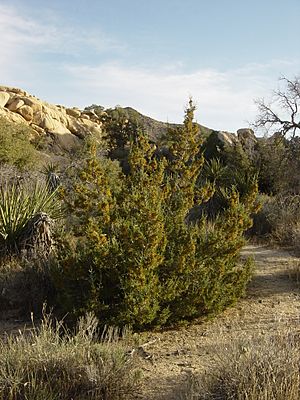California juniper facts for kids
Quick facts for kids California juniper |
|
|---|---|
 |
|
| In Joshua Tree National Park, California | |
| Conservation status | |
| Scientific classification | |
| Genus: |
Juniperus
|
| Species: |
californica
|
 |
|
| Natural range of Juniperus californica | |
 |
|
| Closeup of natural range | |
The California juniper (scientific name: Juniperus californica) is a special type of juniper tree. It grows naturally in the southwestern parts of North America. This tree is known for its tough nature, able to survive in dry, sunny places. It is an important part of many ecosystems in its native range.
Contents
Where Does the California Juniper Grow?
The California juniper mostly grows in California, just like its name says! But you can also find it in Baja California (a part of Mexico), southern Nevada, and northwestern Arizona.
In California, it lives in many different places. These include mountain ranges like the Peninsular Ranges and Sierra Nevada. It also grows in the Mojave Desert at higher elevations.
This juniper prefers to grow at medium heights, usually between 750 and 1,600 meters (about 2,460 to 5,250 feet) above sea level. You can find it in woodlands where pinyon pines or Joshua trees also grow. It also thrives in foothill woodlands and chaparral areas.
What Does the California Juniper Look Like?
The California juniper is usually a shrub or a small tree. It can grow from 3 to 8 meters (about 10 to 26 feet) tall. Sometimes, it can even reach up to 10 meters (33 feet)!
Its bark is a gray color and often looks like it's shredding. The branches are quite thick compared to other junipers. They are about 1.5 to 2 millimeters (0.06 to 0.08 inches) wide.
The leaves are a pretty bluish-gray color and feel like scales. Adult leaves are small, about 1 to 5 millimeters (0.04 to 0.2 inches) long. Young plants have needle-like leaves that are longer, about 5 to 10 millimeters (0.2 to 0.4 inches).
The tree produces berry-like cones. These cones are about 7 to 13 millimeters (0.28 to 0.51 inches) across. They start blue-brown with a waxy coating, then turn reddish-brown. Each cone usually holds one seed, but sometimes two or three. The seeds are ready in about 8 or 9 months.
Male cones are smaller, about 2 to 4 millimeters (0.08 to 0.16 inches) long. They release their pollen in early spring. Most California junipers have either male or female cones, but a few trees have both.
The California juniper is similar to the Utah juniper. Both have thick branches and large cones. However, the Utah juniper usually has both male and female cones on the same plant. Also, its cones take longer to ripen, and it can handle much colder weather.
How Is the California Juniper Used?
The California juniper is very important for local wildlife. It provides food and a safe place for animals like turkeys and deer. Young juniper trees offer good cover for these animals.
This tree is also a food source for the caterpillars of the sequoia sphinx moth.
Native American Uses
Native American groups in California used the California juniper for many things. These groups included the Cahuilla people, Kumeyaay people, and Ohlone people.
They would gather the berries to eat fresh. They also ground the berries into a meal for baking. The wood from the juniper was strong and used to make bows.
Growing California Juniper
People also grow California juniper as an ornamental plant in gardens. It can grow into a dense shrub or a tree. It's a great choice for gardens that need plants that can handle heat and drought. It also helps prevent soil from washing away on dry hills.
The California juniper is also a popular choice for bonsai, which is the art of growing miniature trees.
Conservation Status
The California juniper is currently listed as a species of "Least Concern" by the IUCN. This means it is not considered to be in danger of disappearing globally.
However, one group of these trees on Guadalupe Island (off the coast of Baja California) was sadly destroyed. This happened in the late 1800s because of wild goats eating them.
See also
 In Spanish: Juniperus californica para niños
In Spanish: Juniperus californica para niños



